Environmentalism chapter 5 - Tigers under threat
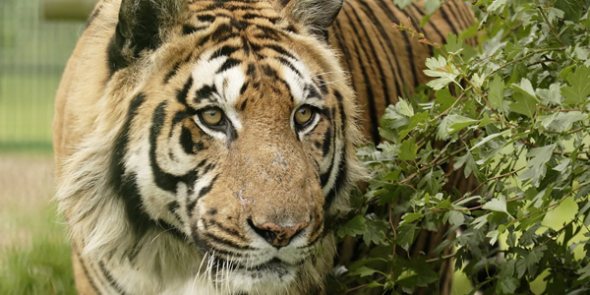
Bengal Tiger - Panthera tigris
The Tiger Panthera tigris the king of the jungle, a stunning species of “Tigers” that are now in serious need of preservation to keep it within the extant centuries to come and not the extinction era.
The Tiger species is the largest of all the big cat species standing at some 11-11.5 feet tall it’s regrettably the most endangered species out of all the wild cat species. Located mostly in east Asia, Russia, Turkey, Bali, India, it lives within large peat grass lands, dense forest and of course its natural areas in Asia where they are mostly located around and within the Ramin tree, (Gonystylus) areas of Indonesia and Malaysia although populated in India where poaching is rife.
With a total body length of just over three meters the Tiger species where wildly populated all over Asia, mainly in Indonesia, Malaysia, India, Japan, Russia and Belize however there numbers have plummeted to alarming levels. Now for 2013 they don’t even stand at 4,000
Bengals and Sumatrans are not the only species within the “Tigris” sub species that are at risk, the largest subspecies the Amur Siberian tiger Panthera tigris altaica is also critically endangered. There are roughly only 3,200 maximum Tigers left in the wild, that is a total in the last century gone of at least 98.5% of all Tiger species banished from the jungles of which they stalk their prey and rely mainly on sight and sound to hunt making them the most sleek predatory hunting cat that walks the earth. There declining numbers are primarily due to;
Tiger population decline;
- Habitual destruction
- Deforestation
- Palm oil and pulp and paper trade
- Human and species conflict
- Poaching
- Skin and fur trade
- Pollution
- Climate change
- Tropical pet trade
- Bone wine trade
- Snare and Traps
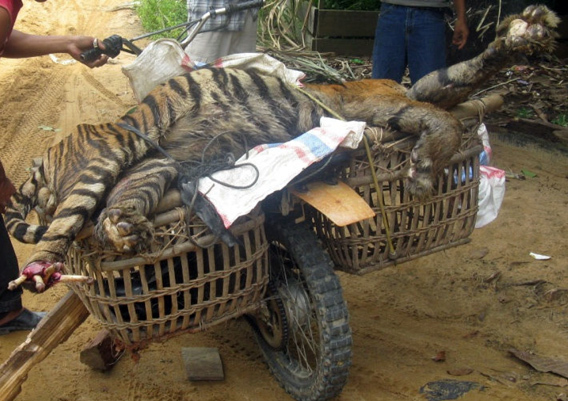
Sumatran tiger killed in an APP supplier’s concession inside the UNESCO Biosphere reserve’s buffer zone in September 2010 © WWF-Indonesia
Read more athttp://news.mongabay.com/2013/0110-dead-tigers-dead-people-sumatra.html#pDHT4oz1xagcoFmG.99
Asia Pulp and Paper we are working to shut down and hold accountable for their destruction of the Sumatran Tiger and Orangutan species. You can help by signing the petition simply by clicking the photo above to help us and other conservationists now take action against them and shut these criminals down. We don’t want to see more animals die as of over consumerism. We have the complaint and papers logged we just need the VOICES. PT KAL are also on our list, of which BOTH companies are listed on the RSPO and both have American owners.. Thanks “America for not caring”
One cannot just blame the poacher with regards to the copiously decreasing numbers of all Tigers although poaching is a contributor one must remember that “humans” that are not even living within the same continent’s as the Tiger species are also contributing to the callous destruction of the Tiger and it’s habitat due to obsessive over consumerism of paper, wood furnishings, to purchasing of foods that have “non-sustainable palm oil” within the product and “sustainable palm oil”.
The sustainable palm oil trade is nothing but a governmental and industrial lie that pushes you in to purchasing more “sustainable” products and “recyclable paper”. Does the industry explain to you though that purchasing of recyclable and sustainable goods is at an all-time high of such sustainable food, paper and wood products? No it lies to you or just stays silent.
With over obsessive consumerism being one of the massive problems why Tigers are savagely murdered everyday then unfortunately we will see the last of the Tigers wiped in one to two years because of this growing consumerism demand hence the quote “sustainable productivity lie” that environmentalists have tried to explain to you for many years now that’s killing the Orang-utans of too due to what you believe is “safe green living and purchasing”.
Excluding climate change vastly in chapter 5 it’s now down to all of us to cut our massive intake of goods and reuse more within the “home” instead of just sending goods to be recycled we now have to “reduce as much as we can” which in turn then decreases deforestation = less habitual destruction that keeps the Tiger species within its natural habitat thus decreasing human species conflict and lowered species birth rate of which the Tiger species normally gives birth to 3-5 cubs a year on average.
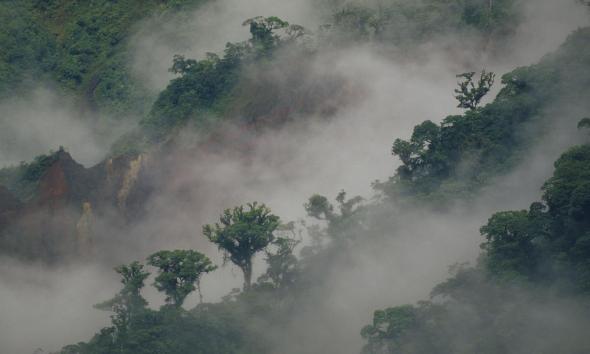
The Tiger species that’s mostly populated to Asia now lives in dense forestry and high grass lands pictured above. Sadly this is under threat with over twelve x football sized pitched sized forests felled a day the Tiger stands no chance. Human and species conflict is common because of this, regrettably the Tiger pays with it’s life which is a sad yet common fact of life that humans around the world are playing a part in with many not even knowing what their habits are causing..
Common knowledge now states the industry cannot keep up with the high demand for “recyclable products”, so to stay with the demand the logging industry then uses more “worked” land over again to non-worked agricultural land.
Commercialisation and massive want for more “recyclable goods” because we believe that we are doing the correct thing by purchasing only recyclable products has then the knock on effect as it would with the non-recyclable industry.
The three R’s is what we at International Animal Rescue Foundation © “promotes” wisely of which one cannot just practice one, and not the other two, by simply using the “recyclable” option and not concentrating on the other two most important factors then this will push the demand up equalling more deforestation. With illegal logging also on the increase then the circle of destruction spirals out of control.
Pollution is also a massive benefactor that is decreasing Tiger populations due to green land forest destruction that equals lowered birth rates, and eventual death. It’s been widely discussed now within our news journal and many other environmental columns that pollution is at a massive high which again is due to over commercialisation and demand. But how does pollution affect the Tiger species?
Air pollution does not only damage the air it also damages living environments on the Earth’s surface and their inhabitants. Plants and animals are harmed by air pollution. Sometimes it is the pollutants themselves that cause damage. Other times pollutants combine and change the resources that plants and animals depend upon such as water, soil, and nutrients. What types of pollutants are damaging this sector that the Tiger lives within though?
Air pollutants called chlorofluorocarbons (or CFCs) destroy ozone molecules in the stratosphere. This has left places in the layer where the ozone is thin. These areas of thin ozone are called ozone holes. The ozone layer, located in the stratosphere layer of Earth’s atmosphere, shields our planet from the Sun’s ultraviolet radiation.
Ultraviolet radiation causes skin cancer and damages plants and wildlife. In recent decades the number of CFCs released into the atmosphere has decreased significantly due to an agreement between the nations of the world called the Montreal Protocol.
Although it takes a long time to see the impact, the ozone holes might someday be smaller. CFCs cause massive damage to the earths wildlife population as of climate change deterioration, damage to tree’s and lower canopy green forestry land that the Tigers desired “prey” rely on which then forces the Tiger to move on mostly to human populated areas thus causing human species conflict. The Tigers prey I have listed below within the few paragraphs on pollutants.
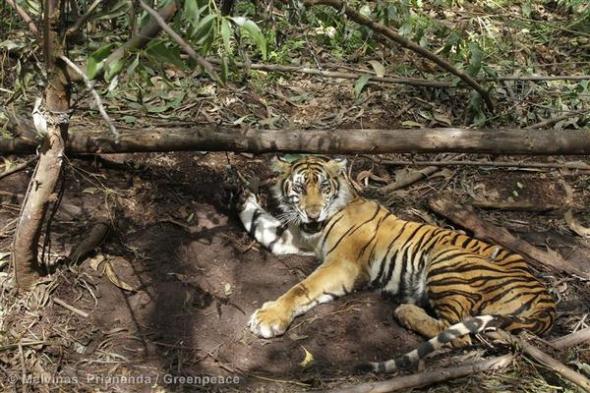
Sumatran and Bengal Tigers are regularly caught in snares and traps set by company paid locals to keep their workers safe that feed the American and European market with pulp, paper, palm oil and wood.
Tropospheric ozone harms living life forms, Ozone molecules in the troposphere damage lung tissues of animals and prevents plant respiration by blocking the openings in leaves, called stomata, where respiration occurs. Tropospheric ozone harms the plants that the prey of the Tiger feeds on thus decreasing again food intake, lack of sufficient prey food intake then kills or forces the animals out of their natural habitat.
Acid rain kills trees and harms animals to heavy industrialised acidic rain that is high in industrialised areas of the forests destroys the leaves of plants and trees without a doubt. When acid rain soaks into the ground, it can make the soil unhealthy for many living species including the Tiger species and its prey. Acid rain also changes the water in lakes and streams, harming fish and other aquatic life.
The short hand documentary shows what we have al known in the environmental world for many years, what is most concerning though is that there are more Tigers in American homes then there are “in the wild” at a rate of over 10,000 (estimate) The tropical pet trade must END now.
The Tiger species has a preference when hunting of which it hunts the Llamas a “type” Equine species however (not Equine related) that has more or less the same skeleton structure but very poor manoeuvrability in the dense jungles hence why the Tiger hunts the Ungulate species that’s relatively easily hunted that can keep a family of mother and cubs living for up to 3-4 days due to high contents of meat and meat saturation fat levels from the Llamas.
The Llamas feed on mainly grass, shrubs, and lichens. Lichens are earth’s first moss plants that grow on rocks and wood. Llamas are herbivores, so pollutants are a very big problem when they are destroying the Tigers natural habitat meaning its hunting grounds. The Tiger then has reduced prey as the Llamas are forced to move on to fresh pastures green which the Tiger cannot as living in such open areas that the Ungulates species can thrive in makes the Tiger more noticeable to its prey thus reducing natural predatory hunting.
Wild boar, buffalo, water buffalo, primates, hares, antelope and specie deer’s plus many more species that the Tiger “species” also hunt can and are effected by pollutants thus displacing the Tiger and it’s prey so yes indeed pollutants are a very big problem along with deforestation, and the humans massive demand for more “recyclable” products of which there is very little reusing and reducing evident in the modern world that we must ALL now start taking notice off.
Reported in this week’s weekend Leader 17th January 2013 and by WWF (World Wild Fund for nature) poaching of the Tiger species was said to have decreased, which is good news, or is it?
Sumatran and Bengal Tiger populations have decreased so dramatically that poachers simply cannot locate these beautiful kings of the jungle anymore which is good but sad news.
Taking a brief look into figures here and history we can see an awfully shocking trend that one must “not” just blame as quoted on the poacher. We all have to except the blame as explained above regarding pollutants, over commercialisation and obsessive consumerism.
The tiger population dropped over the past 100 years from an estimated 100,000 in the 1900’s to only 4000 in the 1970’s. A concerted effort by wildlife protection groups in the 1970’s halted their rapid demise and the global population of tigers in the wild has grown modestly to around 6000 at the turn of the century with great thanks to then Indian Prime minster that launched a massive operation to cease hunting that was being fronted by the illegal poaching industry, everyone breathed a sigh of relief as the Tiger population then shot back up which hadn’t the Indian president taken action then all Indian native Tigers would have been lost.
Poaching continues to this day though all over Asia and Russia, however. When a Russian poacher can make as much from a single tiger kill as he would normally earn in 6 years, it will take more than words to halt this tragedy it takes “skill and going back to our grass roots to understanding the Tiger and it’s preys natural habitat”. Only then can one preserve the Tiger species.
The range of tigers has changed over the past 100 years. Once roaming all throughout India, Southeast Asia they now only small live in pockets of small natural habitat. Law enforcement has not lowered poaching it’s unfortunately the massive declines in numbers of the Tiger species.
Quote
“In the 1970’s we came dangerously close to losing forever one of the world most magnificent creatures. Poaching, deforestation, and human expansion to pollution brought all species of tiger to the brink of extinction. Indeed, over the past centuries, 3 of the 8 sub-species that existed became extinct the Caspian, Javan and Balinese tigers. Today, we are by no means out of the woods. All remaining sub-species of tiger are endangered, making the tiger species as a whole nearly extinct”
The news report of which I have copied below from the Weekend leader wrote 17th January, quote;
In cheering news for wildlife conservationists, tiger poaching dropped nearly 60 per cent in 2011 as compared to the previous year, though it continues to pose a major threat to the survival of the big cat in the country, a leading NGO said. According to the Wildlife Protection Society of India (WPSI), 13 tigers were hunted last year as compared to 30 in 2010 - a decline of 57 per cent. The bodies of poached tigers, seized bones and skins were computed to arrive at the figures.
Adding other factors like road accidents, infighting, fighting with other animals, electrocution, found dead, and rescue and treatment, the overall toll rises to 61. In 2010, it was 58. However, top on the list of WPSI’s tiger mortality is the found dead figure, 21.
The toll from infighting was the same as that of poaching. In the previous year, 10 tigers died in such fights. “There has been definitely a decrease in poaching cases in 2011 compared to 2010, but it does not mean poaching has stopped,” said WPSI’s Tito Joseph. This could be “due to effective patrolling strategies adopted by the tiger authority (National Tiger Conservation Authority) in coordination with other agencies,” Joseph said. The illegal wildlife trade continues to be a major threat to tigers. Joseph said traders were offering huge amounts of money in black markets for tiger body parts.
“Recently trade activities were detected in Vietnam and Cambodia. The threat is not only from China (a known hub for such trade) but also from Southeast Asian countries,” he said. “We need to be vigilant 24 hours 365 days,” Joseph said. “Wildlife articles always have a very premium market and prices are not going to come down easily,” says U.C. Tiwari, wildlife warden of the Corbett National Park, Uttarakhand. The 1,200-plus sq km Corbett sanctuary is one of the 39 tiger reserves in the country.
The poaching figure only reflects the cases that come to light and it may not truly reflect the ground condition, said Tiwari. He warned that the situation could turn alarming if the mortality rate of adult tigers rises. “Because adult tigers don’t die easily… there has to be some extraordinary circumstance.” According to WPSI, of the 21 tigers found dead in 2011 many were adult tigers. In 2010, 15 tigers were found dead.
“The fact that many poachers are now lodged in jails has surely contributed to the decrease. They are still cooling their heels in different jails,” the official added. Acknowledging this, Ashok Kumar, an eminent tiger conservationist and vice chairman of the NGO Wildlife Trust of India, said poaching has reduced considerably as many poachers were jailed. “Our lawyers fight against them in court so they do not come out of jails.
“All Alwar (Rajasthan)-based poachers are today in jails,” said Kumar, referring to a gang blamed for extermination of tigers in the Sariska reserve, one of the two tiger sanctuaries in the state.
Kumar has been at the forefront of the fight against poachers and illegal trade of wildlife for over two decades. He was the first director of Traffic India, which studies wildlife trade.
Rajasthan is also home to the famed Ranthambore National Park. Sariska currently has five tigers, all shifted from Ranthambore as part of a government attempt to repopulate tigers in the reserve. The latest official tiger census report released in March 2011 estimated about 1,700 tigers in the country. – IANS
Reports for 2012 show other alarming figures though that pinpoint to “exactly what we have been informing the DEA South Africa of and India too” please read the link http://www.guardian.co.uk/environment/2012/aug/20/tiger-population-india-tourism-ban
The Rhinoceros in South Africa when we International Animal Rescue Foundation © started Operation Trojan Horse proved that “tourists where being watched to even “poachers” joining the damn tourists with no one law authority even aware of this.
These alarming finds were sent immediately to the DEA (Department of Environmental Affairs) South Africa and tour guides informing them to keep check of who is actually on their safari tour guides to entering South Africa.
India would ONLY do this IF they knew that poachers where becoming even more brazenly operational and daring by acting as tourists, then giving pin point geographical locations of Rhinoceros crashes hence we now believe 100% with evidence that we have, that the poacher is undertaking the same methods of infiltrating the South African tourists mobile travel safaris in South Africa as they are now in India.
We don’t believe that the poaching has decreased at all because of arrests made and increased patrols we believe that poaching has decreased simply because there are very few Tigers within the wild of which the Bengal and the Sumatran are the sought after Tigers. In an extracted article the following was quoted http://www.wtop.com/41/2968728/World-tiger-population-approaching-possible-extinction
Badaling Safari World - Beijing sell Tiger Bone within the zoo. It’s illegal hence why the permit states dispose of the bones and skin discretely so the government “know this” yet couldn’t care less.The investigation back from 2007-2008 by the EIA clearly shows the laws being broken. The Tigers do not die naturally they are staved to death hence why the large import and export of this illegal liquor, Some Tigers are kept back of which they are force breed. http://youtu.be/Rwv8mCw8JJs
“There are only 500 to 600 Sumatran tigers left in the world, so they hope to breed Kavi with one of the zoo’s youngest females. The zoo only has three Sumatran tigers right now.
In August of 2012 there was an exact number of one thousand Sumatran Tigers Panthera tigris sumatrae so since August and January 2013 “someone is not giving the correct figures out” We knew there was only 1000 left in the wild as of Greenpeace’s investigations into the Ramin tree, palm oil and pulp and paper trade.
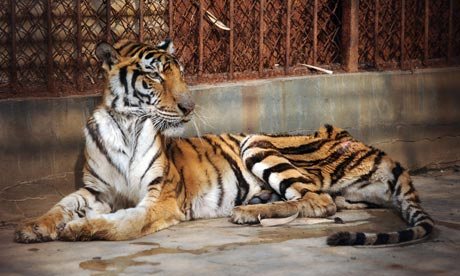
On checking the full story in this zoo it was horrifying, these are protected and endangered species and this is how we treat them. The world has gone insane and sadly there are more zoos in Asia just like this.
With regards to the Bengal Tiger Panthera tigris there are literally 2,500 in the wild to date. The total number of Tigers in the wild that does not include the Siberian equals 3000 to 3100. The Siberian Tiger that’s critically endangered numbers at what some conservationists have quoted without taking into account scientific analysis is 500 – 600 however this is untrue.
Approximately 500 Amur tigers actually survive in the wild, but the effective population is a measure of the genetic diversity of the world’s largest cat. Very low diversity means any vulnerability to disease or rare genetic disorders are likely to be passed on to the next generation. So these results paint a grim picture for the tiger’s chance of survival.
“The findings are reported in the journal Mammalian Biology”
The Amur tiger, or Siberian tiger as it is also known, once lived across a large portion of northern China, the Korean peninsula, and the southernmost regions of eastern Russia. During the early 20th Century, the Amur tiger was almost driven to extinction, as expanding human settlements, habitat loss and poaching wiped out this biggest of cats from over 90% of its range.
By the 1940s, just 20 to 30 individuals survived in the wild. The new study has identified that this recent “genetic bottleneck” - when the breeding population of tigers was so critically low - has decimated the Amur tiger gene pool.
A more genetically diverse population of animals has a much better chance of survival; it is more likely, for example, to contain the genetic resistance to a variety of diseases and less likely to succumb to rare genetic disorders, which can be “cancelled out” by healthy genes.
Scientists in Russia, Spain and Germany worked together to analyse DNA samples from 15 wild Amur tigers in the Russian Far East. They took blood samples from the animals and screened them for certain “markers” - points in the DNA code that show that an animal had parents that were genetically very different from each other.
The results revealed evidence of the genetic bottleneck during the tigers’ recent history, when the variety of genes is being passed on dramatically reduced. Genetically speaking, the Amur tiger has not recovered from this. “Our results are the first to demonstrate a quite recent genetic bottleneck in Siberian tigers, a result that matches the well-documented severe demographic decline of the Siberian tiger population in the 1940s,” the researchers wrote in the paper.
“The worryingly low effective population size challenges the optimism for the recovery of the huge Siberian cat.”
Our total from number count of Tigers from scientific findings, investigations and worldwide knowledge estimates the entire Tiger species to now be under 3.400 and should pollution, obsessive consumerism, increasing commercialisation that increases climate change and impulse purchasing now not reside or drop then the tiger species coupled with poaching “will be extinct in two years or less” and that’s fact, along with that will then follow the Lion, Pangolin and the Rhinoceros species.
Bone wine trade and “skin or fur” trade is also a major benefactor that see’s the Tiger regrettably poached, Tigers are critically endangered and therefore non-tradable, the Asian government know damn well that Tigers are prohibited by International Union for Conservation of Nature laws from being moved or poached, CITES also prohibits such illegal activity of which traders to sellers MUST be shut down, fined and/or prosecuted. Such criminal activity is just ignored though and what part Asia actually play in helping to save any animal after viewing the EIA investigations in to blood ivory is still to be seen.
Be the voice - Help us to shut APP down, they are murderers and environmental desecration experts



